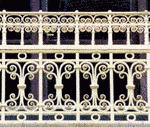wrought iron
a. a pure form of iron having a low carbon content and a fibrous microstructure. It is made by various processes and is often used for decorative work
b. (as modifier): wrought-iron gates
Collins Discovery Encyclopedia, 1st edition © HarperCollins Publishers 2005
wrought iron
1. A commercially pure iron of fibrous nature, valued for its corrosion resistance and ductility; used for water pipes, water tank plates, rivets, and other forged work.

 See also: Metal
See also: Metal2. 

An easily forged iron containing carbon. It can be hammered into shapes, either when hot or cold, and is used as decorative grilles for window openings, entryways, or balcony railings.


Illustrated Dictionary of Architecture Copyright © 2012, 2002, 1998 by The McGraw-Hill Companies, Inc. All rights reserved
wrought iron
[′rȯt ′ī·ərn] (metallurgy)
A commercial iron consisting of slag fibers, primarily iron silicate, embedded in a ferrite matrix.
McGraw-Hill Dictionary of Scientific & Technical Terms, 6E, Copyright © 2003 by The McGraw-Hill Companies, Inc.
wrought iron
A commercially pure iron of fibrous nature; valued for its corrosion resistance and ductility; used for water pipes, water tank plates, rivets, stay bolts, and forged work.
McGraw-Hill Dictionary of Architecture and Construction. Copyright © 2003 by McGraw-Hill Companies, Inc.
The following article is from The Great Soviet Encyclopedia (1979). It might be outdated or ideologically biased.
Wrought Iron
a commercial iron obtained through old production methods directly from iron ore or pig iron. The spongy masses of iron (blooms) formed in a furnace or hearth consists of iron crystals of high purity mixed with a certain quantity of uniformly distributed liquid slag. Upon extraction from the furnace or hearth, the hot bloom is subjected to forging or rolling, as a result of which the slag is ejected and the iron crystals are fused. Wrought iron has excellent mechanical properties, for example, malleability, corrosion resistance, and weldability. By the 1950’s wrought iron had been almost entirely replaced by steel.
The Great Soviet Encyclopedia, 3rd Edition (1970-1979). © 2010 The Gale Group, Inc. All rights reserved.